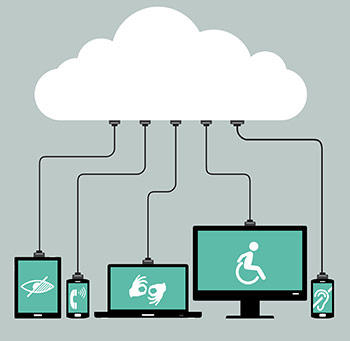
Virginia works for a federal agency. She cannot use her hands because of a spinal cord injury, so she relies on a speech recognition system to operate her email and other applications. As her work group moves to a cloud-based software program, her work future is up in the air because the cloud-based software is incompatible with her speech recognition program.
This is one of several hypothetical scenarios described in Cloud Computing and Accessibility Considerations, a new draft publication from the National Institute of Standards and Technology (NIST) Cloud Accessibility Public Working Group. It explores difficulties that employees with disabilities may encounter as organizations migrate to the cloud, where software and information at a remote location is accessed through the Internet, instead of from local computers.
"Cloud Computing and Accessibility Considerations examines the challenges, barriers and opportunities federal information technology managers face to comply with both the federal government's accessibility requirements—Section 508 of the Rehabilitation Act—and the federal Cloud First policy," said Robert Bohn, NIST's cloud computing technology program manager.
Amended in 1998 to include information systems, Section 508 of the Rehabilitation Act requires employers to provide equal access to computers and other information technology devices for workers with disabilities. The federal government's "Cloud First" policy calls for federal agencies to implement cloud computing when secure, reliable and cost-effective opportunities are available.
NIST, the agency designated to accelerate the federal government's secure adoption of cloud computing, organized the public working group in response to requests from accessibility experts during the 2011 review of the U.S. Government Cloud Computing Technology Roadmap.
In addition to providing eight known "experiences of inaccessibility," or challenges with new IT technology—some provided by federal employees with disabilities—the publication lists barriers specific to cloud-computing environments. One such barrier occurs when a cloud provider automatically upgrades its software and the new version is incompatible with products that aid accessibility, as in Virginia's case above.
The working group analyzed popular cloud applications, such as email and calendars, to identify potential accessibility barriers and how to prevent them.
The group also developed a cloud computing accessibility taxonomy, or vocabulary, to provide a common language to discuss problems and solutions, and to use during procurement of information systems.
The report describes two promising examples of cloud-based accessibility.
- Incorporating accessibility application programming interfaces (API)—tools for building software—to enable easy integration of voice recognition software and other specialized tools into operating systems. This is not only a benefit to people with disabilities, but in the age of cloud computing and mobile devices, such APIs offer competitive advantages, including efficiency, flexibility and ability to adapt to future devices.
- The Global Public Inclusive Infrastructure (GPII) is a framework that a consortium of academic, industry and nongovernmental organizations and individuals is developing to improve accessibility to all information and communication technology products regardless of disability or usability issues. Once the GPII is in place, users will be able to satisfy their accessibility needs and store their preferences in the cloud. That way, they will be able to use a variety of devices, including an ATM or a friend's tablet.
NIST's Cloud Computing Accessibility Public Working Group is requesting comments on the draft of Cloud Computing and Accessibility Considerations, Special Publication 500-317. Please fill out the comment template and send to Robert.Bohn [at] nist.gov (Robert[dot]Bohn[at]nist[dot]gov) with the subject line, "Comments on Draft Special Publication 500-317," by April 29, 2016.

